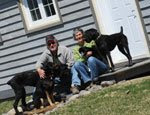 But the walk around the grounds was wonderful.
But the walk around the grounds was wonderful.
 Here is a plaque showing the footprint of the fort:
Here is a plaque showing the footprint of the fort: From the descriptions on the sign:
From the descriptions on the sign: A ravelin is a triangular defensive work built in the ditch in front of the curtain wall.
The glacis is a slope of land approaching a fortification which is shaped so all areas are exposed to cannon fire.
The covered way is a kind of road that runs around the ditch and is protected by the slope of the glacis. Often an earthen step was located on the covered way for soldiers to stand on and fire down the glacis.
The ditch is a trench around the fortifications that slows the advance of attacking troops.
The glacis is a slope of land approaching a fortification which is shaped so all areas are exposed to cannon fire.
The covered way is a kind of road that runs around the ditch and is protected by the slope of the glacis. Often an earthen step was located on the covered way for soldiers to stand on and fire down the glacis.
The ditch is a trench around the fortifications that slows the advance of attacking troops.
The Powder Magazine
 Built by the French in 1708 the powder magazine was used to store the fort's gunpowder. It is the only surviving building from the French period. And, as you can see by the photo below, the soldiers must have been a lot shorter back then...we had to stoop to get through the door.
Built by the French in 1708 the powder magazine was used to store the fort's gunpowder. It is the only surviving building from the French period. And, as you can see by the photo below, the soldiers must have been a lot shorter back then...we had to stoop to get through the door. Charles Fort (information below from a sign at Fort Anne)
Charles Fort (information below from a sign at Fort Anne)A group of about 70 Scottish settlers began a colony here in 1629, eight years after King James I granted "Nova Scotia" to Sir William Alexander. Led by Alexander's son, the Scots built a small fort, the remains of which lie beneath Fort Anne. Despite many deaths during the first winter, the surviving colonists thrived on agriculture, fishing, and trade with the Mi'kmaq. Most returned to Great Britain in 1632 after France reacquired the region by treaty. Although the colonization attempt was short-lived, the province of Nova Scotia owes its name, flag, and coat of arms to this early Scottish settlement.



No comments:
Post a Comment